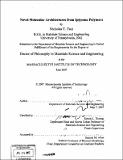Novel molecular architectures from iptycene polymers
Author(s)
Tsui, Nicholas T. (Nicholas Tang)
DownloadFull printable version (38.13Mb)
Other Contributors
Massachusetts Institute of Technology. Dept. of Materials Science and Engineering.
Advisor
Edwin L. Thomas.
Terms of use
Metadata
Show full item recordAbstract
This thesis explored the incorporation of iptycenes into polymers as a means to enhance the mechanical properties. Iptycene structures were targeted because they possess a unique structural property called internal molecular free volume. When these bulky pendant groups are incorporated into the backbone of a polymer chain, they produce a novel chain architecture called molecular barbed wire. This molecular barbed wire architecture not only influences individual polymer chain dynamics but also induces lateral interactions between polymer chains through the minimization of internal molecular free volume. Work began by developing the concepts of internal molecular free volume and how to exploit its minimization. A formal definition for this property was created along with methods to identify and quantify its existence. Experimental results document the effects of introducing this property into polyesters and polycarbonates. Two specific novel inter-chain interactions were established: molecular threading and molecular interlocking. These steric interactions between polymers chains generate a non-bonded, network morphology and actively enhance the mechanical properties during deformation. (cont.) It was demonstrated that the stiffness, strength and ductility of polymers could be enhanced simultaneously through this method. Mechanical properties were observed in tension at quasistatic deformation rates and in compression at both quasistatic and ballistic deformation rates. Improved mechanical performances were related back to structural properties through x-ray scattering experiments. Concepts of internal molecular free volume were necessary to explain the structure-property relationships observed. In addition, a prototype of enhanced polycarbonate was successfully developed for possible use in protective armor applications. This work provides a new pathway for the continued research and development in the field of ballistic protection.
Description
Thesis (Ph. D.)--Massachusetts Institute of Technology, Dept. of Materials Science and Engineering, 2007. Includes bibliographical references (p. 201-215).
Date issued
2007Department
Massachusetts Institute of Technology. Department of Materials Science and EngineeringPublisher
Massachusetts Institute of Technology
Keywords
Materials Science and Engineering.